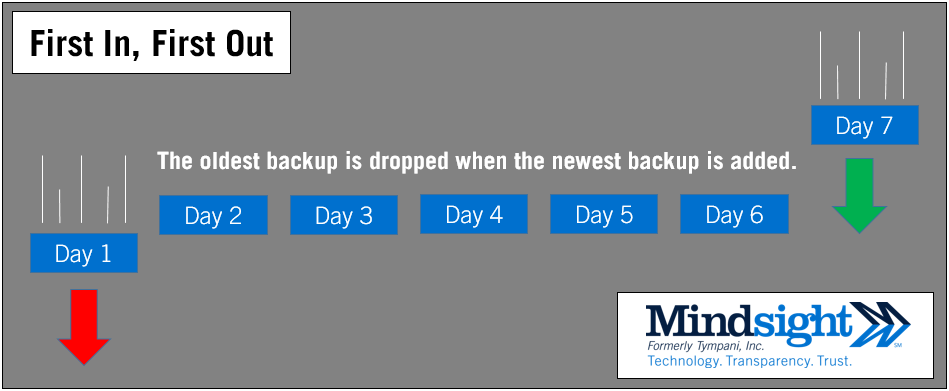February 7, 2017
Tape backup poses a significant challenge to those who use it as their primary backup strategy. Trying to keep every single roll of tape ever recorded by the company would quickly become unwieldy, and without a defined system, it would be impossible to guarantee that the right backup would be available when it’s needed. In response to this dynamic, three data backup rotation schemes arose over the years. They are known as the First In, First Out Scheme; the Grandfather, Father, Son Scheme; and the Tower of Hanoi Scheme. Each system is unique in its own right, but they all attempt to organize an ever-growing inventory of tape backup copies.
Three Systems to Organize Your Tape Backup Inventory
First In, First Out
Our first scheme is the simplest, and that is both its best asset and its biggest drawback. In the First In, First Out Scheme, the IT director must first choose how many days of backups the company wishes to store—be it 14, 50, or 365 backups. The actual number of backups in the inventory is entirely up to the company’s preference. However, when a new tape is added, the oldest tape in inventory is removed, so the total number of tapes in the inventory remains consistent. As the name explains, the first (or oldest) tape in is the first tape out.

Grandfather, Father, Son
Grandfather, Father, Son works a bit differently. Instead of a set number of backups replaced one by one, you have “generations” of backups. The newest backups are considered to be the youngest generation or “sons.” As the sons become older, they become fathers and create their own sons, and on and on it goes. In practical terms, this could mean that the “son” is yesterday’s backup. The “father” is last week’s backup. The “grandfather” is last month’s backup. As time progresses, these backups will earn higher titles as they get further and further from the current point in time.

The Tower of Hanoi
The Tower of Hanoi is by far the most complex of the schemes detailed here. However, a certain level of manageable complexity is a good thing for a data backup strategy. The scheme is named after the old puzzle game wherein the player must move a tower of rings one at a time from one peg to a third peg without placing a lower ring atop a higher ring. Effectively, this means that the first tape in a cycle is used every other day, the second tape is every fourth day, and a third tape is used every other day. Refer to the diagram below.

Each time a letter reappears in the cycle, that tape is overwritten. Therefore, the tape that recorded day 1 is the same tape that will be overwritten to record day 3. As you can see by the diagram above, this four tape cycle ensures there is a backup for every day of the week, but as you add more tapes to the scheme, they are backed up less and less. This is an efficient way to keep the number of overall tapes low, while still maintaining monthly, semi-annual, and annual tapes and ensuring that there are no overlaps.
Disk and Cloud Backup Alternatives
Though disk and cloud backup solutions have been on the market for years, there are still many companies depending on tape as their primary backup strategy. It is certainly possible to use a tape-only strategy, but the conveniences and reliability of an automated disk or cloud alternative are very attractive. In both instances, you no longer need to physically transport tapes off-site, and your repository of backups is immediately accessible via the corporate network. Those points alone create a strong case against the continued use of tape.
Download Our FREE White Paper — Moving Away From Tape
Tape is going away, disk is the new medium, and the cloud is disrupting everything. Download Mindsight’s free white paper to learn more about the state of the backup industry in 2017. We cover the advantages of each strategy, point out the shortcomings that have created the need for a new comprehensive solution, and provide our own best recommendations.
Get your copy of Moving Away from Tape: Strategies for Advancing to a More Modern Backup Solution today.
Like what you read?
About Mindsight
Mindsight, a Chicago IT services provider, is an extension of your team. Our culture is built on transparency and trust, and our team is made up of extraordinary people – the kinds of people you would hire. We have one of the largest expert-level engineering teams delivering the full spectrum of IT services and solutions, from cloud to infrastructure, collaboration to contact center. Our highly-certified engineers and process-oriented excellence have certainly been key to our success. But what really sets us apart is our straightforward and honest approach to every conversation, whether it is for an emerging business or global enterprise. Our customers rely on our thought leadership, responsiveness, and dedication to solving their toughest technology challenges.
Contact us at GoMindsight.com.
